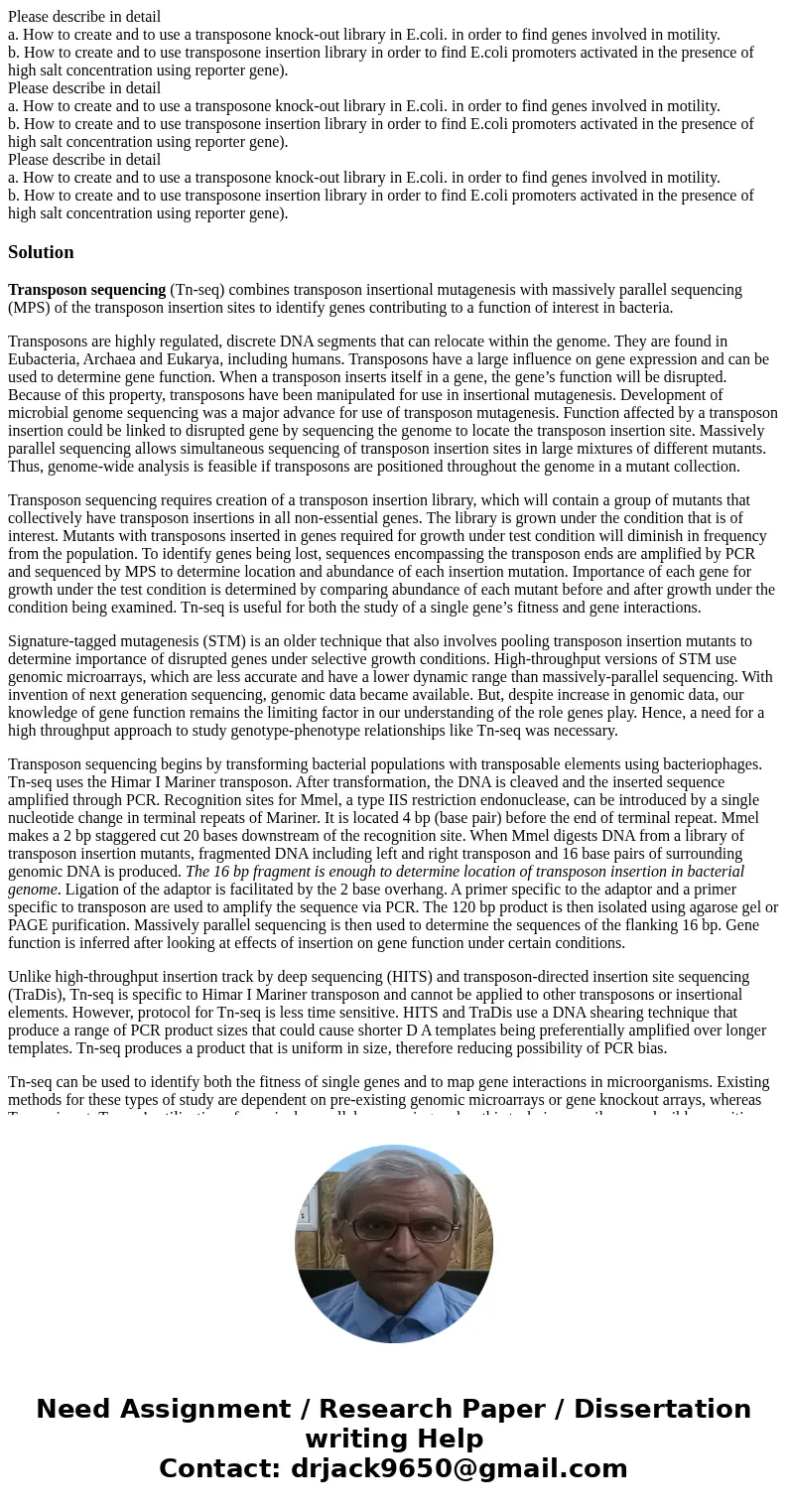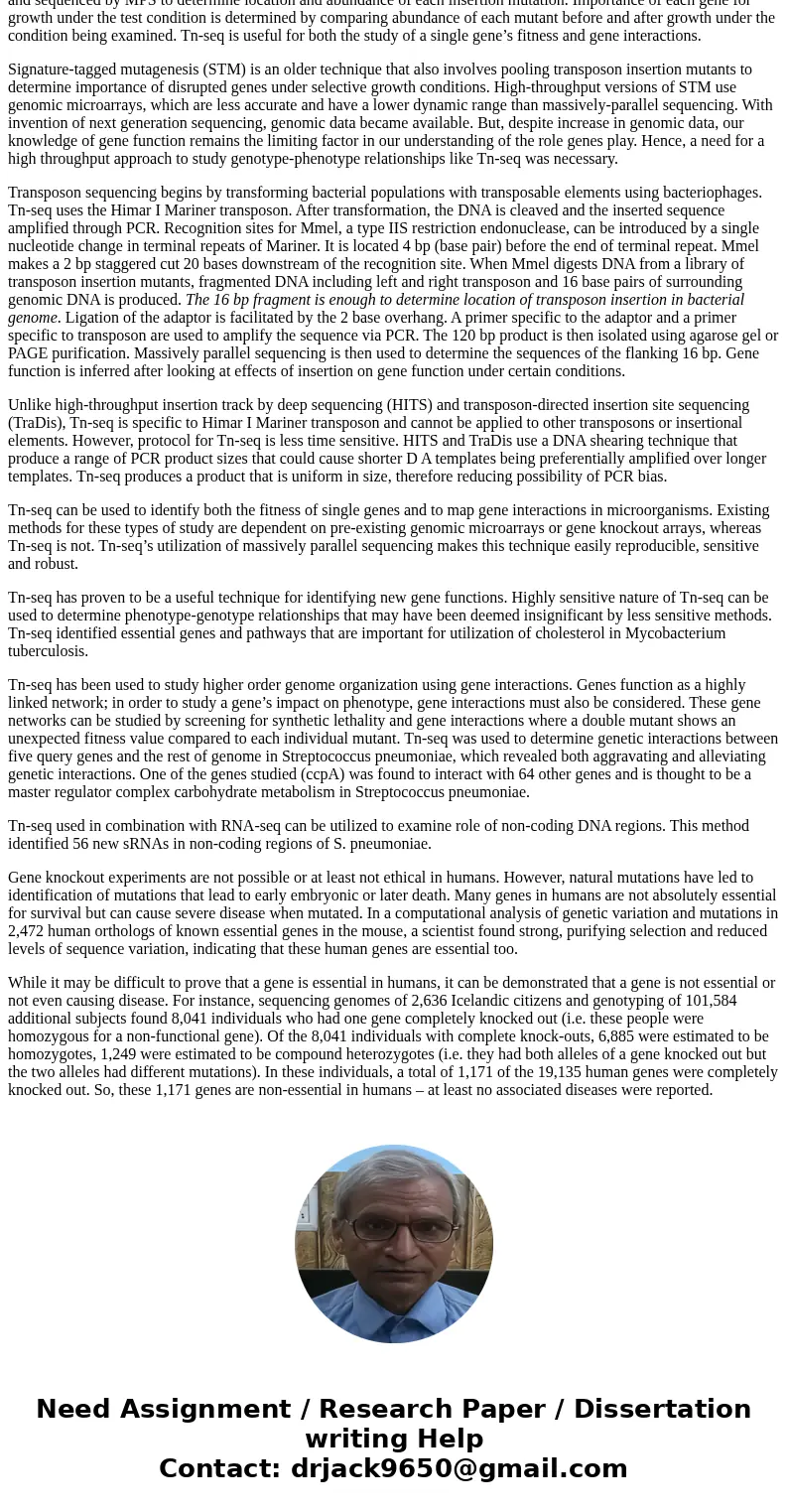Please describe in detail a How to create and to use a trans
Solution
Transposon sequencing (Tn-seq) combines transposon insertional mutagenesis with massively parallel sequencing (MPS) of the transposon insertion sites to identify genes contributing to a function of interest in bacteria.
Transposons are highly regulated, discrete DNA segments that can relocate within the genome. They are found in Eubacteria, Archaea and Eukarya, including humans. Transposons have a large influence on gene expression and can be used to determine gene function. When a transposon inserts itself in a gene, the gene’s function will be disrupted. Because of this property, transposons have been manipulated for use in insertional mutagenesis. Development of microbial genome sequencing was a major advance for use of transposon mutagenesis. Function affected by a transposon insertion could be linked to disrupted gene by sequencing the genome to locate the transposon insertion site. Massively parallel sequencing allows simultaneous sequencing of transposon insertion sites in large mixtures of different mutants. Thus, genome-wide analysis is feasible if transposons are positioned throughout the genome in a mutant collection.
Transposon sequencing requires creation of a transposon insertion library, which will contain a group of mutants that collectively have transposon insertions in all non-essential genes. The library is grown under the condition that is of interest. Mutants with transposons inserted in genes required for growth under test condition will diminish in frequency from the population. To identify genes being lost, sequences encompassing the transposon ends are amplified by PCR and sequenced by MPS to determine location and abundance of each insertion mutation. Importance of each gene for growth under the test condition is determined by comparing abundance of each mutant before and after growth under the condition being examined. Tn-seq is useful for both the study of a single gene’s fitness and gene interactions.
Signature-tagged mutagenesis (STM) is an older technique that also involves pooling transposon insertion mutants to determine importance of disrupted genes under selective growth conditions. High-throughput versions of STM use genomic microarrays, which are less accurate and have a lower dynamic range than massively-parallel sequencing. With invention of next generation sequencing, genomic data became available. But, despite increase in genomic data, our knowledge of gene function remains the limiting factor in our understanding of the role genes play. Hence, a need for a high throughput approach to study genotype-phenotype relationships like Tn-seq was necessary.
Transposon sequencing begins by transforming bacterial populations with transposable elements using bacteriophages. Tn-seq uses the Himar I Mariner transposon. After transformation, the DNA is cleaved and the inserted sequence amplified through PCR. Recognition sites for Mmel, a type IIS restriction endonuclease, can be introduced by a single nucleotide change in terminal repeats of Mariner. It is located 4 bp (base pair) before the end of terminal repeat. Mmel makes a 2 bp staggered cut 20 bases downstream of the recognition site. When Mmel digests DNA from a library of transposon insertion mutants, fragmented DNA including left and right transposon and 16 base pairs of surrounding genomic DNA is produced. The 16 bp fragment is enough to determine location of transposon insertion in bacterial genome. Ligation of the adaptor is facilitated by the 2 base overhang. A primer specific to the adaptor and a primer specific to transposon are used to amplify the sequence via PCR. The 120 bp product is then isolated using agarose gel or PAGE purification. Massively parallel sequencing is then used to determine the sequences of the flanking 16 bp. Gene function is inferred after looking at effects of insertion on gene function under certain conditions.
Unlike high-throughput insertion track by deep sequencing (HITS) and transposon-directed insertion site sequencing (TraDis), Tn-seq is specific to Himar I Mariner transposon and cannot be applied to other transposons or insertional elements. However, protocol for Tn-seq is less time sensitive. HITS and TraDis use a DNA shearing technique that produce a range of PCR product sizes that could cause shorter D A templates being preferentially amplified over longer templates. Tn-seq produces a product that is uniform in size, therefore reducing possibility of PCR bias.
Tn-seq can be used to identify both the fitness of single genes and to map gene interactions in microorganisms. Existing methods for these types of study are dependent on pre-existing genomic microarrays or gene knockout arrays, whereas Tn-seq is not. Tn-seq’s utilization of massively parallel sequencing makes this technique easily reproducible, sensitive and robust.
Tn-seq has proven to be a useful technique for identifying new gene functions. Highly sensitive nature of Tn-seq can be used to determine phenotype-genotype relationships that may have been deemed insignificant by less sensitive methods. Tn-seq identified essential genes and pathways that are important for utilization of cholesterol in Mycobacterium tuberculosis.
Tn-seq has been used to study higher order genome organization using gene interactions. Genes function as a highly linked network; in order to study a gene’s impact on phenotype, gene interactions must also be considered. These gene networks can be studied by screening for synthetic lethality and gene interactions where a double mutant shows an unexpected fitness value compared to each individual mutant. Tn-seq was used to determine genetic interactions between five query genes and the rest of genome in Streptococcus pneumoniae, which revealed both aggravating and alleviating genetic interactions. One of the genes studied (ccpA) was found to interact with 64 other genes and is thought to be a master regulator complex carbohydrate metabolism in Streptococcus pneumoniae.
Tn-seq used in combination with RNA-seq can be utilized to examine role of non-coding DNA regions. This method identified 56 new sRNAs in non-coding regions of S. pneumoniae.
Gene knockout experiments are not possible or at least not ethical in humans. However, natural mutations have led to identification of mutations that lead to early embryonic or later death. Many genes in humans are not absolutely essential for survival but can cause severe disease when mutated. In a computational analysis of genetic variation and mutations in 2,472 human orthologs of known essential genes in the mouse, a scientist found strong, purifying selection and reduced levels of sequence variation, indicating that these human genes are essential too.
While it may be difficult to prove that a gene is essential in humans, it can be demonstrated that a gene is not essential or not even causing disease. For instance, sequencing genomes of 2,636 Icelandic citizens and genotyping of 101,584 additional subjects found 8,041 individuals who had one gene completely knocked out (i.e. these people were homozygous for a non-functional gene). Of the 8,041 individuals with complete knock-outs, 6,885 were estimated to be homozygotes, 1,249 were estimated to be compound heterozygotes (i.e. they had both alleles of a gene knocked out but the two alleles had different mutations). In these individuals, a total of 1,171 of the 19,135 human genes were completely knocked out. So, these 1,171 genes are non-essential in humans – at least no associated diseases were reported.


 Homework Sourse
Homework Sourse